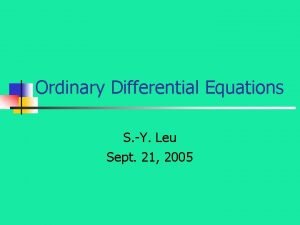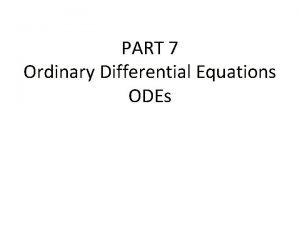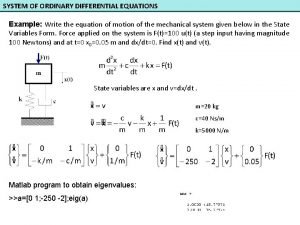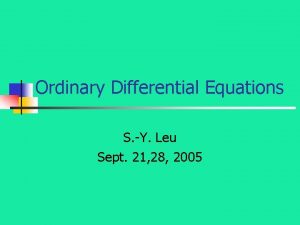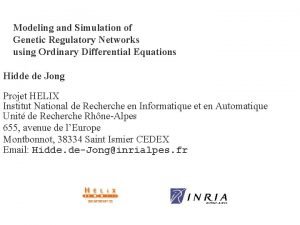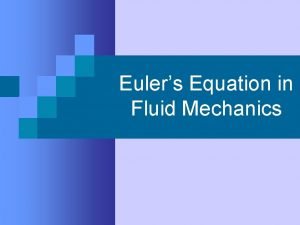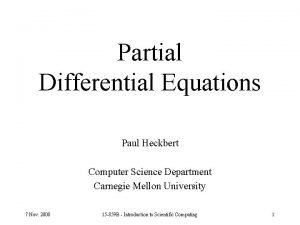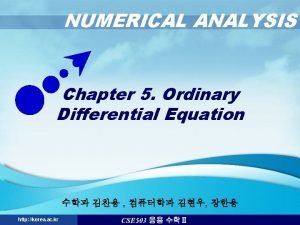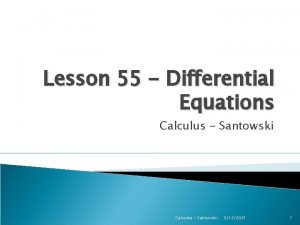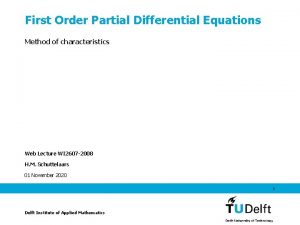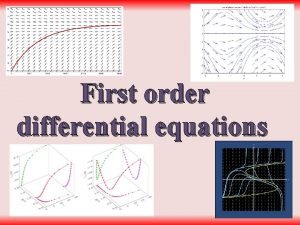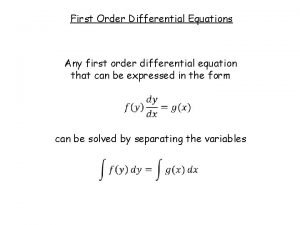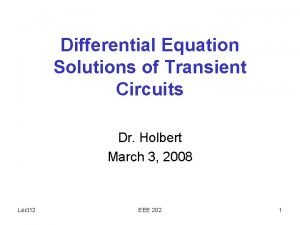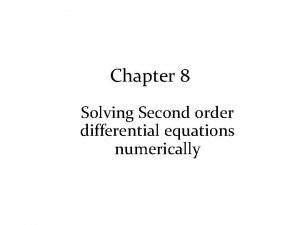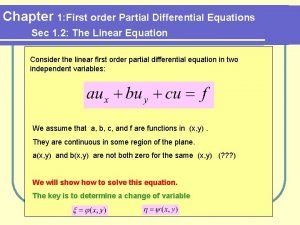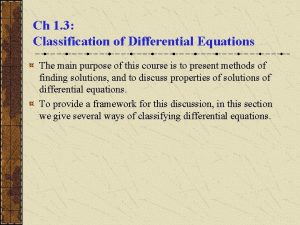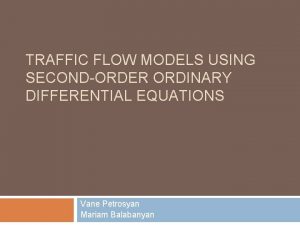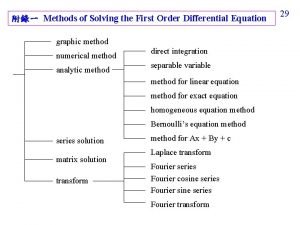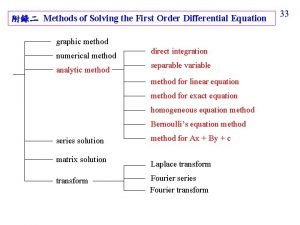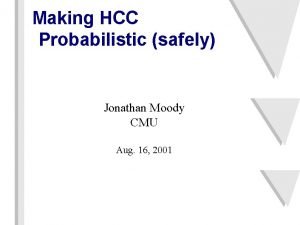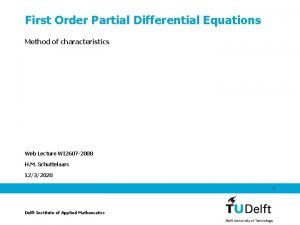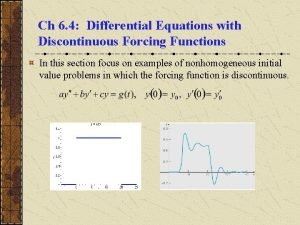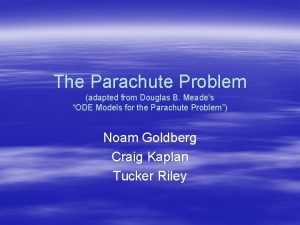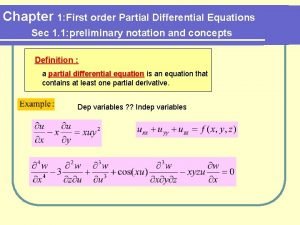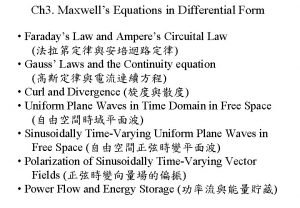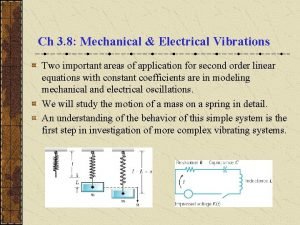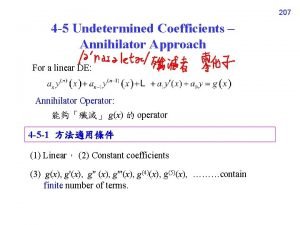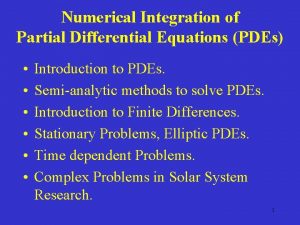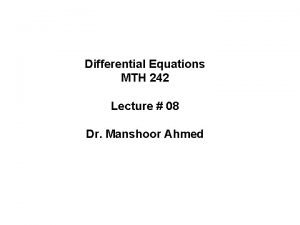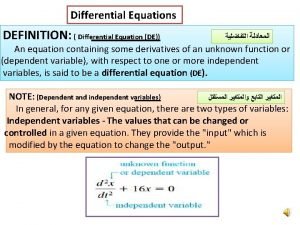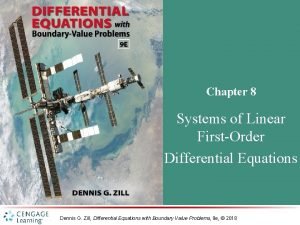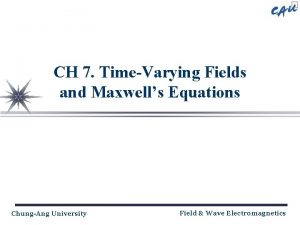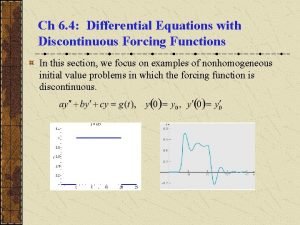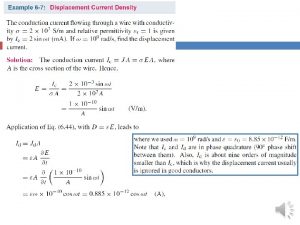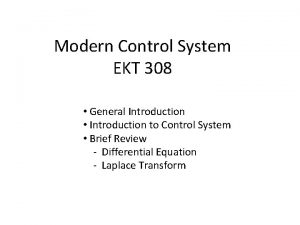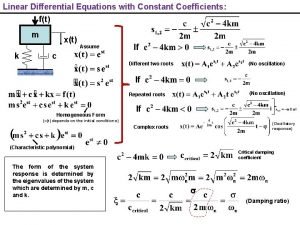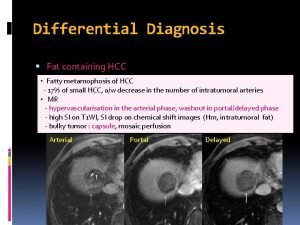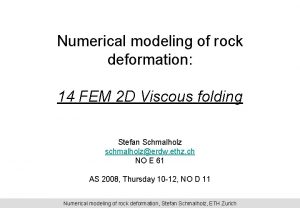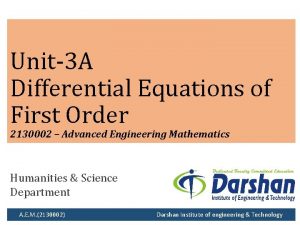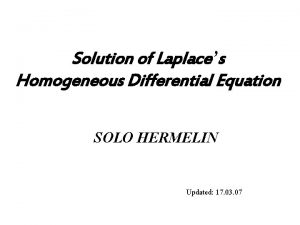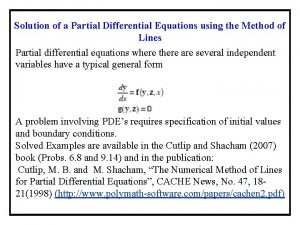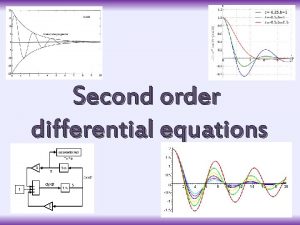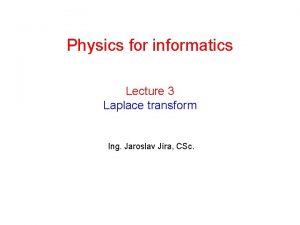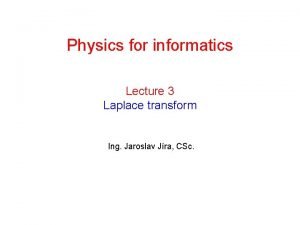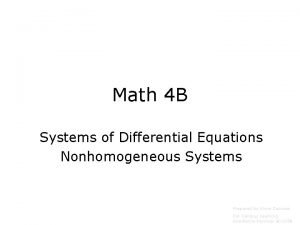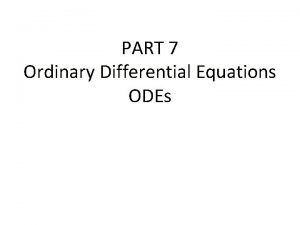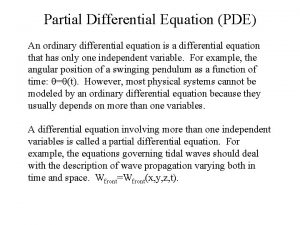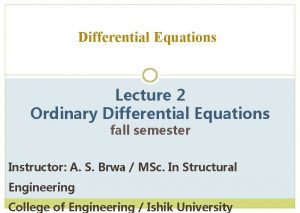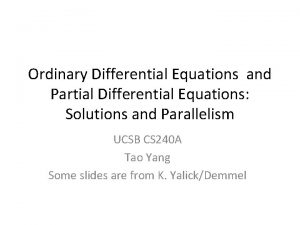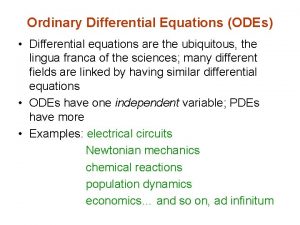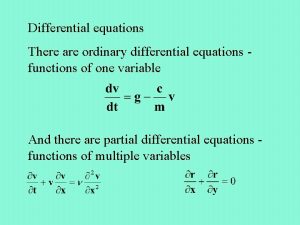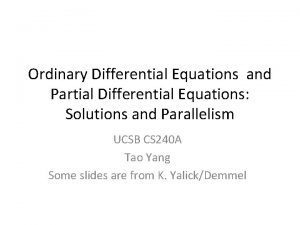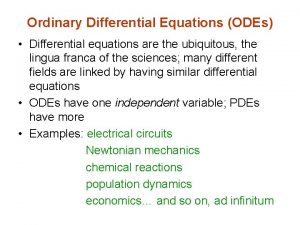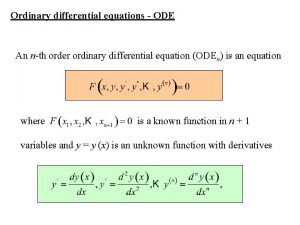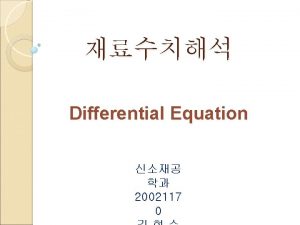Lecture 4 Ordinary Differential Equations Differential equation An


































































- Slides: 66

化 應用數學 授課教師: 郭修伯 Lecture 4 Ordinary Differential Equations

Differential equation • An equation relating a dependent variable to one or more independent variables by means of its differential coefficients with respect to the independent variables is called a “differential equation”. Ordinary differential equation -------only one independent variable involved: x Partial differential equation -------more than one independent variable involved: x, y, z,

Order and degree • The order of a differential equation is equal to the order of the highest differential coefficient that it contains. • The degree of a differential equation is the highest power of the highest order differential coefficient that the equation contains after it has been rationalized. 3 rd order O. D. E. 1 st degree O. D. E.

Linear or non-linear • Differential equations are said to be nonlinear if any products exist between the dependent variable and its derivatives, or between the derivatives themselves. Product between two derivatives ---- non-linear Product between the dependent variable themselves ---- non-linear

First order differential equations • No general method of solutions of 1 st O. D. E. s because of their different degrees of complexity. • Possible to classify them as: – exact equations – equations in which the variables can be separated – homogenous equations – equations solvable by an integrating factor

Exact equations • Exact? General solution: F (x, y) = C For example

Separable-variables equations • In the most simple first order differential equations, the independent variable and its differential can be separated from the dependent variable and its differential by the equality sign, using nothing more than the normal processes of elementary algebra. For example

Homogeneous equations • Homogeneous/nearly homogeneous? • A differential equation of the type, is termed a homogeneous differential equation of the first order. • Such an equation can be solved by making the substitution u = y/x and thereafter integrating the transformed equation.

Homogeneous equation example • Liquid benzene is to be chlorinated batchwise by sparging chlorine gas into a reaction kettle containing the benzene. If the reactor contains such an efficient agitator that all the chlorine which enters the reactor undergoes chemical reaction, and only the hydrogen chloride gas liberated escapes from the vessel, estimate how much chlorine must be added to give the maximum yield of monochlorbenzene. The reaction is assumed to take place isothermally at 55 C when the ratios of the specific reaction rate constants are: k 1 = 8 k 2 ; k 2 = 30 k 3 C 6 H 6+Cl 2 C 6 H 5 Cl +HCl C 6 H 5 Cl+Cl 2 C 6 H 4 Cl 2 + HCl C 6 H 4 Cl 2 + Cl 2 C 6 H 3 Cl 3 + HCl

Take a basis of 1 mole of benzene fed to the reactor and introduce the following variables to represent the stage of system at time , p = moles of chlorine present q = moles of benzene present r = moles of monochlorbenzene present s = moles of dichlorbenzene present t = moles of trichlorbenzene present Then q + r + s + t = 1 and the total amount of chlorine consumed is: y = r + 2 s + 3 t From the material balances : in - out = accumulation u = r/q

Equations solved by integrating factor • There exists a factor by which the equation can be multiplied so that the one side becomes a complete differential equation. The factor is called “the integrating factor”. where P and Q are functions of x only Assuming the integrating factor R is a function of x only, then is the integrating factor

Example Solve Let z = 1/y 3 integral factor

Summary of 1 st O. D. E. • First order linear differential equations occasionally arise in chemical engineering problems in the field of heat transfer, momentum transfer and mass transfer.

First O. D. E. in heat transfer An elevated horizontal cylindrical tank 1 m diameter and 2 m long is insulated with asbestos lagging of thickness l = 4 cm, and is employed as a maturing vessel for a batch chemical process. Liquid at 95 C is charged into the tank and allowed to mature over 5 days. If the data below applies, calculated the final temperature of the liquid and give a plot of the liquid temperature as a function of time. Liquid film coefficient of heat transfer (h 1) = 150 W/m 2 C Thermal conductivity of asbestos (k) = 0. 2 W/m C Surface coefficient of heat transfer by convection and radiation (h 2) = 10 W/m 2 C Density of liquid ( ) = 103 kg/m 3 Heat capacity of liquid (s) = 2500 J/kg. C Atmospheric temperature at time of charging = 20 C Atmospheric temperature (t) t = 10 + 10 cos ( /12) Time in hours ( ) Heat loss through supports is negligible. The thermal capacity of the lagging can be ignored.

Area of tank (A) = ( x 1 x 2) + 2 ( 1 / 4 x 12 ) = 2. 5 m 2 Rate of heat loss by liquid = h 1 A (T - Tw) Rate of heat loss through lagging = k. A/l (Tw - Ts) Rate of heat loss from the exposed surface of the lagging = h 2 A (Ts - t) At steady state, the three rates are equal: Considering thermal equilibrium of the liquid, input rate - output rate = accumulation rate t Ts T Tw B. C. = 0 , T = 95

Second O. D. E. • Purpose: reduce to 1 st O. D. E. • Likely to be reduced equations: – Non-linear • Equations where the dependent variable does not occur explicitly. • Equations where the independent variable does not occur explicitly. • Homogeneous equations. – Linear • The coefficients in the equation are constant • The coefficients are functions of the independent variable.

Non-linear 2 nd O. D. E. - Equations where the dependent variables does not occur explicitly • They are solved by differentiation followed by the p substitution. • When the p substitution is made in this case, the second derivative of y is replaced by the first derivative of p thus eliminating y completely and producing a first O. D. E. in p and x.

Solve Let and therefore integral factor error function

Non-linear 2 nd O. D. E. - Equations where the independent variables does not occur explicitly • They are solved by differentiation followed by the p substitution. • When the p substitution is made in this case, the second derivative of y is replaced as Let

Solve Let Separating the variables and therefore

Non-linear 2 nd O. D. E. - Homogeneous equations • The homogeneous 1 st O. D. E. was in the form: • The corresponding dimensionless group containing the 2 nd differential coefficient is • In general, the dimensionless group containing the nth coefficient is • The second order homogenous differential equation can be expressed in a form analogous to , viz. Assuming u = y/x If in this form, called homogeneous 2 nd ODE Assuming x = et

Solve Dividing by 2 xy homogeneous Singular solution Let General solution Let

A graphite electrode 15 cm in diameter passes through a furnace wall into a water cooler which takes the form of a water sleeve. The length of the electrode between the outside of the furnace wall and its entry into the cooling jacket is 30 cm; and as a safety precaution the electrode in insulated thermally and electrically in this section, so that the outside furnace temperature of the insulation does not exceed 50 C. If the lagging is of uniform thickness and the mean overall coefficient of heat transfer from the electrode to the surrounding atmosphere is taken to be 1. 7 W/C m 2 of surface of electrode; and the temperature of the electrode just outside the furnace is 1500 C, estimate the duty of the water cooler if the temperature of the electrode at the entrance to the cooler is to be 150 C. The following additional information is given. Surrounding temperature = 20 C Thermal conductivity of graphite k. T = k 0 - T = 152. 6 - 0. 056 T W/m C The temperature of the electrode may be assumed uniform at any cross-section. T 0 T x

The sectional area of the electrode A = 1/4 x 0. 152 = 0. 0177 m 2 A heat balance over the length of electrode x at distance x from the furnace is input - output = accumulation where U = overall heat transfer coefficient from the electrode to the surroundings D = electrode diameter T 0 T x

Integrating factor

Linear differential equations • They are frequently encountered in most chemical engineering fields of study, ranging from heat, mass, and momentum transfer to applied chemical reaction kinetics. • The general linear differential equation of the nth order having constant coefficients may be written: where (x) is any function of x.

2 nd order linear differential equations The general equation can be expressed in the form where P, Q, and R are constant coefficients Let the dependent variable y be replaced by the sum of the two new variables: y = u + v Therefore If v is a particular solution of the original differential equation The general solution of the linear differential equation will be the sum of a “complementary function” and a “particular solution”. purpose

The complementary function Let the solution assumed to be: auxiliary equation (characteristic equation) Unequal roots Equal roots Real roots Complex roots

Unequal roots to auxiliary equation • Let the roots of the auxiliary equation be distinct and of values m 1 and m 2. Therefore, the solutions of the auxiliary equation are: • The most general solution will be • If m 1 and m 2 are complex it is customary to replace the complex exponential functions with their equivalent trigonometric forms.

Solve auxiliary function

Equal roots to auxiliary equation • Let the roots of the auxiliary equation equal and of value m 1 = m 2 = m. Therefore, the solution of the auxiliary equation is: Let where V is a function of x

Solve auxiliary function

Solve auxiliary function

Particular integrals • Two methods will be introduced to obtain the particular solution of a second linear O. D. E. – The method of undetermined coefficients • confined to linear equations with constant coefficients and particular form of (x) – The method of inverse operators • general applicability

Method of undetermined coefficients • When (x) is constant, say C, a particular integral of equation is • When (x) is a polynomial of the form where all the coefficients are constants. The form of a particular integral is • When (x) is of the form Terx, where T and r are constants. The form of a particular integral is

Method of undetermined coefficients • When (x) is of the form G sin nx + H cos nx, where G and H are constants, the form of a particular solution is • Modified procedure when a term in the particular integral duplicates a term in the complementary function.

Solve auxiliary equation Equating coefficients of equal powers of x

Method of inverse operators • Sometimes, it is convenient to refer to the symbol “D” as the differential operator: But,

The differential operator D can be treated as an ordinary algebraic quantity with certain limitations. (1) The distribution law: A(B+C) = AB + AC which applies to the differential operator D (2) The commutative law: AB = BA which does not in general apply to the differential operator D Dxy x. Dy (D+1)(D+2)y = (D+2)(D+1)y (3) The associative law: (AB)C = A(BC) which does not in general apply to the differential operator D D(Dy) = (DD)y D(xy) = (Dx)y + x(Dy) The basic laws of algebra thus apply to the pure operators, but the relative order of operators and variables must be maintained.

Differential operator to exponentials More convenient!

Differential operator to trigonometrical functions where “Im” represents the imaginary part of the function which follows it.

The inverse operator The operator D signifies differentiation, i. e. • D-1 is the “inverse operator” and is an “intergrating” operator. • It can be treated as an algebraic quantity in exactly the same manner as D

Solve differential operator binomial expansion =2


Solve differential operator y = yc + yp f(p) = 0 integration

Solve differential operator y = yc + yp expanding each term by binomial theorem

O. D. E in Chemical Engineering • A tubular reactor of length L and 1 m 2 in cross section is employed to carry out a first order chemical reaction in which a material A is converted to a product B, A B • The specific reaction rate constant is k s-1. If the feed rate is u m 3/s, the feed concentration of A is Co, and the diffusivity of A is assumed to be constant at D m 2/s. Determine the concentration of A as a function of length along the reactor. It is assumed that there is no volume change during the reaction, and that steady state conditions are established.

L u C 0 Ce The concentraion will vary in the entry section due to diffusion, but will not vary in the section following the reactor. (Wehner and Wilhelm, 1956) u C x 分開兩個section x x x+ x Bulk flow of A Diffusion of A A material balance can be taken over the element of length x at a distance x fom the inlet Input - Output + Generation = Accumulation

dividing by x rearranging In the entry section auxillary function

B. C. if diffusion is neglected (D 0) B. C.

The continuous hydrolysis of tallow in a spray column 連續牛油水解 Glycerin, 甘油 1. 017 kg/s of a tallow fat mixed with 0. 286 kg/s of high pressure hot water is fed into the base of a spray column operated at a temperature 232 C and a pressure of 4. 14 MN/m 2. 0. 519 kg/s of water at the same temperature and pressure is sprayed into the top of the column and descends in the form of droplets through the rising fat phase. Glycerine is generated in the fat phase by the hydrolysis reaction and is extracted by the descending water so that 0. 701 kg/s of final extract containing 12. 16% glycerine is withdrawn continuously from the column base. Simultaneously 1. 121 kg/s of fatty acid raffinate containing 0. 24% glycerine leaves the top of the column. If the effective height of the column is 2. 2 m and the diameter 0. 66 m, the glycerine equivalent in the entering tallow 8. 53% and the distribution ratio of glycerine between the water and the fat phase at the column temperature and pressure is 10. 32, estimate the concentration of glycerine in each phase as a function of column height. Also find out what fraction of the tower height is required principally for the chemical reaction. The hydrolysis reaction is pseudo first order and the specific reaction rate constant is 0. 0028 s-1.

Raffinate L kg/s x. H z. H x+ x z+ z h Tallow fat x z G kg/s y. H y+ y h y Hot water G kg/s Extract x 0 z 0 y 0 x = weight fraction of glycerine in raffinate y = weight fraction of glycerine in extract y*= weight fraction of glycerine in extract in equilibrium with x z = weight fraction of hydrolysable fat in raffinate

Consider the changes occurring in the element of column of height h: Glycerine transferred from fat to water phase, Rate of destruction of fat by hydrolysis, Rate of production of glycerine by hydrolysis, S: sectional area of tower k: specific reaction rate constant a: interfacial area per volume of tower : mass of fat per unit volume of column (730 kg/m 3) K: overall mass transter coefficient w: kg fat per kg glycetine A glycerine balance over the element h is: L kg/s x. H z. H in the fat phase in the extract phase A glycerine balance between the element and the base of the tower is: in the fat phase in the extract phase The glycerine equilibrium between the phases is: x+ x z+ z G kg/s y. H y+ y h h x z y x 0 z 0 y 0

2 nd O. D. E. with constant coefficients Complementary function Particular solution Constant at the right hand side, yp = C/R

B. C. We don’t know y 0, either We don’t really want x here! Apply the equations two slides earlier (replace y* with mx) Substitute y 0 in terms of other variables


Simultaneous differential equations • These are groups of differential equations containing more than one dependent variable but only one independent variable. • In these equations, all the derivatives of the different dependent variables are with respect to the one independent variable. Our purpose: Use algebraic elemination of the variables until only one differential equation relating two of the variables remains.

Elimination of variable Independent variable or dependent variables? Elimination of independent variable 較少用 Elimination of one or more dependent variables It involves with equations of high order and it would be better to make use of matrices Solving differential equations simultaneously using matrices will be introduced later in the term

Elimination of dependent variables Solve

=E y = yc + yp

Example of simultaneous O. D. E. s 1. 25 kg/s of sulphuric acid (heat capacity 1500 J/kg C) is to be cooled in a two-stage countercurrent cooler of the following type. Hot acid at 174 C is fed to a tank where it is well stirred in contact with cooling coils. The continuous discharge from this tank at 88 C flows to a second stirred tank and leaves at 45 C. Cooling water at 20 C flows into the coil of the second tank and thence to the coil of the first tank. The water is at 80 C as it leaves the coil of the hot acid tank. To what temperatures would the contents of each tank rise if due to trouble in the supply, the cooling water suddenly stopped for 1 h? On restoration of the water supply, water is put on the system at the rate of 1. 25 kg/s. Calculate the acid discharge temperature after 1 h. The capacity of each tank is 4500 kg of acid and the overall coefficient of heat transfer in the hot tank is 1150 W/m 2 C and in the colder tank 750 W/m 2 C. These constants may be assumed constant.

Tank 1 80 C 40 C Tank 2 20 C 0. 96 kg/s 88 C 1. 25 kg/s 45 C 174 C Heat transfer area A 1 Steady state calculation: Heat transfer area A 2 Heat capacity of water 4200 J/kg C Note: 和單操課本不同

When water fails for 1 hour, heat balance for tank 1 and tank 2: Tank 1 M: mass flow rate of acid C: heat capacity of acid V: mass capacity of tank Ti: temperature of tank i Tank 2 B. C. t = 0, T 1 = 88 t = 1, T 1=142. 4 C integral factor, et B. C. t = 0, T 2 = 45 t = 1, T 2 = 94. 9 C

When water supply restores after 1 hour, heat balance for tank 1 and tank 2: Tank 1 Tank 2 t 1 T 0 t 2 1 T 1 t 3 2 T 2 W: mass flow rate of water Cw: heat capacity of water t 1: temperature of water leaving tank 1 t 2: temperature of water leaving tank 2 t 3: temperature of water entering tank 2 Heat transfer rate equations for the two tanks: 4 equations have to be solved simultaneously


基本上,1 st order O. D. E. 應該都解的出來,方法不外乎: Check exact Separate variables homogenous equations, u = y/x equations solvable by an integrating factor 2 nd order 以上的O. D. E Non-linear O. D. E. 我們會解的部分 Linear O. D. E. 缺 x 的 O. D. E. , reduced to 1 st O. D. E. 缺 y 的 O. D. E. , reduced to 1 st O. D. E. homogeneous 的 O. D. E. , u = y/x General solution = complementary solution + particular solution variable coefficient? 用數列解,next course 我們會解的部分 constant coefficients 尋找特殊解的方法 The method of undetermined coefficients The method of inverse operators
 Partial differential equations ppt
Partial differential equations ppt First order differential equation formula
First order differential equation formula Linear differential equation formula
Linear differential equation formula Midpoint method formula
Midpoint method formula Ordinary differential equations example
Ordinary differential equations example Non linear ode
Non linear ode Ordinary differential equation
Ordinary differential equation What is ordinary point
What is ordinary point Bernoulli's equation differential equations
Bernoulli's equation differential equations Euler's equation fluids
Euler's equation fluids 01:640:244 lecture notes - lecture 15: plat, idah, farad
01:640:244 lecture notes - lecture 15: plat, idah, farad Differential equations projects
Differential equations projects Classification of pde examples
Classification of pde examples Cengage differential equations
Cengage differential equations Kutta
Kutta Differential calculus
Differential calculus Partial differential equations
Partial differential equations Separation of variables
Separation of variables Partial differential equations examples
Partial differential equations examples First order ode
First order ode Solving 1st order differential equations
Solving 1st order differential equations Cengage differential equations
Cengage differential equations Natural solution
Natural solution How to solve second order differential equations
How to solve second order differential equations Solving 1st order differential equations
Solving 1st order differential equations Definition and classification of differential equations
Definition and classification of differential equations Traffic flow differential equations
Traffic flow differential equations Euler algorithm
Euler algorithm First order linear equation
First order linear equation Variable separable
Variable separable Hcc differential equations
Hcc differential equations Differential equations
Differential equations Differential equations with discontinuous forcing functions
Differential equations with discontinuous forcing functions Parachute problem differential equations
Parachute problem differential equations Homogeneous differential equation definition
Homogeneous differential equation definition Introduction to linear algebra strang
Introduction to linear algebra strang Growth and decay differential equation
Growth and decay differential equation Differential equations zill solutions
Differential equations zill solutions Stewart differential equations
Stewart differential equations Highest order chapter 1
Highest order chapter 1 Hertz
Hertz Mechanical and electrical vibrations
Mechanical and electrical vibrations Annihilator approach
Annihilator approach Integration of partial differential equation
Integration of partial differential equation Higher order linear differential equations
Higher order linear differential equations Define differential equation
Define differential equation Mixing problems differential equations
Mixing problems differential equations Derivation of maxwell's equations in differential form
Derivation of maxwell's equations in differential form Differential equations with discontinuous forcing functions
Differential equations with discontinuous forcing functions Derivation of maxwell's equations in differential form
Derivation of maxwell's equations in differential form Partial differential equations
Partial differential equations Differential equations summary
Differential equations summary Logistic growth curve equation
Logistic growth curve equation Coefficient method
Coefficient method Hcc differential equations
Hcc differential equations Numerical methods for partial differential equations eth
Numerical methods for partial differential equations eth Polar to rectangular equation
Polar to rectangular equation Translate word equations to chemical equations
Translate word equations to chemical equations Differential equation types
Differential equation types Solo hermelin
Solo hermelin General solution of partial differential equation
General solution of partial differential equation 2nd order homogeneous differential equation
2nd order homogeneous differential equation Laplace transform shift
Laplace transform shift Laplace transform of differential equation
Laplace transform of differential equation Differential equation basics
Differential equation basics Differential equation exponential solution
Differential equation exponential solution Find the general solution of the differential equation
Find the general solution of the differential equation

